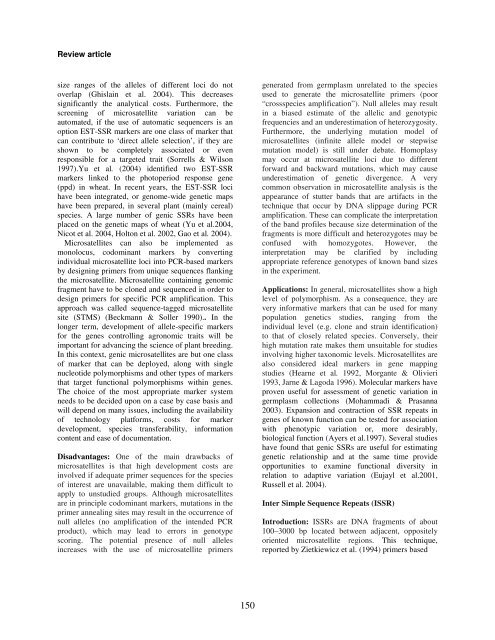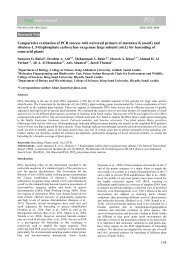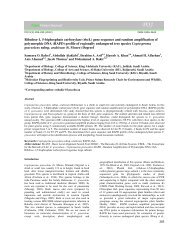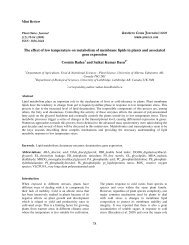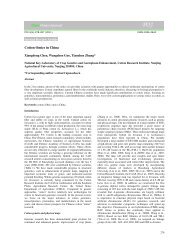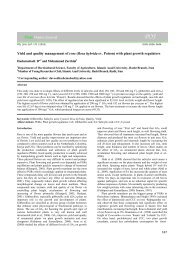Potential of Molecular Markers in Plant Biotechnology - ResearchGate
Potential of Molecular Markers in Plant Biotechnology - ResearchGate
Potential of Molecular Markers in Plant Biotechnology - ResearchGate
You also want an ePaper? Increase the reach of your titles
YUMPU automatically turns print PDFs into web optimized ePapers that Google loves.
Review article<br />
size ranges <strong>of</strong> the alleles <strong>of</strong> different loci do not<br />
overlap (Ghisla<strong>in</strong> et al. 2004). This decreases<br />
significantly the analytical costs. Furthermore, the<br />
screen<strong>in</strong>g <strong>of</strong> microsatellite variation can be<br />
automated, if the use <strong>of</strong> automatic sequencers is an<br />
option EST-SSR markers are one class <strong>of</strong> marker that<br />
can contribute to ‘direct allele selection’, if they are<br />
shown to be completely associated or even<br />
responsible for a targeted trait (Sorrells & Wilson<br />
1997).Yu et al. (2004) identified two EST-SSR<br />
markers l<strong>in</strong>ked to the photoperiod response gene<br />
(ppd) <strong>in</strong> wheat. In recent years, the EST-SSR loci<br />
have been <strong>in</strong>tegrated, or genome-wide genetic maps<br />
have been prepared, <strong>in</strong> several plant (ma<strong>in</strong>ly cereal)<br />
species. A large number <strong>of</strong> genic SSRs have been<br />
placed on the genetic maps <strong>of</strong> wheat (Yu et al.2004,<br />
Nicot et al. 2004, Holton et al. 2002, Gao et al. 2004).<br />
Microsatellites can also be implemented as<br />
monolocus, codom<strong>in</strong>ant markers by convert<strong>in</strong>g<br />
<strong>in</strong>dividual microsatellite loci <strong>in</strong>to PCR-based markers<br />
by design<strong>in</strong>g primers from unique sequences flank<strong>in</strong>g<br />
the microsatellite. Microsatellite conta<strong>in</strong><strong>in</strong>g genomic<br />
fragment have to be cloned and sequenced <strong>in</strong> order to<br />
design primers for specific PCR amplification. This<br />
approach was called sequence-tagged microsatellite<br />
site (STMS) (Beckmann & Soller 1990).. In the<br />
longer term, development <strong>of</strong> allele-specific markers<br />
for the genes controll<strong>in</strong>g agronomic traits will be<br />
important for advanc<strong>in</strong>g the science <strong>of</strong> plant breed<strong>in</strong>g.<br />
In this context, genic microsatellites are but one class<br />
<strong>of</strong> marker that can be deployed, along with s<strong>in</strong>gle<br />
nucleotide polymorphisms and other types <strong>of</strong> markers<br />
that target functional polymorphisms with<strong>in</strong> genes.<br />
The choice <strong>of</strong> the most appropriate marker system<br />
needs to be decided upon on a case by case basis and<br />
will depend on many issues, <strong>in</strong>clud<strong>in</strong>g the availability<br />
<strong>of</strong> technology platforms, costs for marker<br />
development, species transferability, <strong>in</strong>formation<br />
content and ease <strong>of</strong> documentation.<br />
Disadvantages: One <strong>of</strong> the ma<strong>in</strong> drawbacks <strong>of</strong><br />
microsatellites is that high development costs are<br />
<strong>in</strong>volved if adequate primer sequences for the species<br />
<strong>of</strong> <strong>in</strong>terest are unavailable, mak<strong>in</strong>g them difficult to<br />
apply to unstudied groups. Although microsatellites<br />
are <strong>in</strong> pr<strong>in</strong>ciple codom<strong>in</strong>ant markers, mutations <strong>in</strong> the<br />
primer anneal<strong>in</strong>g sites may result <strong>in</strong> the occurrence <strong>of</strong><br />
null alleles (no amplification <strong>of</strong> the <strong>in</strong>tended PCR<br />
product), which may lead to errors <strong>in</strong> genotype<br />
scor<strong>in</strong>g. The potential presence <strong>of</strong> null alleles<br />
<strong>in</strong>creases with the use <strong>of</strong> microsatellite primers<br />
generated from germplasm unrelated to the species<br />
used to generate the microsatellite primers (poor<br />
“crossspecies amplification”). Null alleles may result<br />
<strong>in</strong> a biased estimate <strong>of</strong> the allelic and genotypic<br />
frequencies and an underestimation <strong>of</strong> heterozygosity.<br />
Furthermore, the underly<strong>in</strong>g mutation model <strong>of</strong><br />
microsatellites (<strong>in</strong>f<strong>in</strong>ite allele model or stepwise<br />
mutation model) is still under debate. Homoplasy<br />
may occur at microsatellite loci due to different<br />
forward and backward mutations, which may cause<br />
underestimation <strong>of</strong> genetic divergence. A very<br />
common observation <strong>in</strong> microsatellite analysis is the<br />
appearance <strong>of</strong> stutter bands that are artifacts <strong>in</strong> the<br />
technique that occur by DNA slippage dur<strong>in</strong>g PCR<br />
amplification. These can complicate the <strong>in</strong>terpretation<br />
<strong>of</strong> the band pr<strong>of</strong>iles because size determ<strong>in</strong>ation <strong>of</strong> the<br />
fragments is more difficult and heterozygotes may be<br />
confused with homozygotes. However, the<br />
<strong>in</strong>terpretation may be clarified by <strong>in</strong>clud<strong>in</strong>g<br />
appropriate reference genotypes <strong>of</strong> known band sizes<br />
<strong>in</strong> the experiment.<br />
Applications: In general, microsatellites show a high<br />
level <strong>of</strong> polymorphism. As a consequence, they are<br />
very <strong>in</strong>formative markers that can be used for many<br />
population genetics studies, rang<strong>in</strong>g from the<br />
<strong>in</strong>dividual level (e.g. clone and stra<strong>in</strong> identification)<br />
to that <strong>of</strong> closely related species. Conversely, their<br />
high mutation rate makes them unsuitable for studies<br />
<strong>in</strong>volv<strong>in</strong>g higher taxonomic levels. Microsatellites are<br />
also considered ideal markers <strong>in</strong> gene mapp<strong>in</strong>g<br />
studies (Hearne et al. 1992, Morgante & Olivieri<br />
1993, Jarne & Lagoda 1996). <strong>Molecular</strong> markers have<br />
proven useful for assessment <strong>of</strong> genetic variation <strong>in</strong><br />
germplasm collections (Mohammadi & Prasanna<br />
2003). Expansion and contraction <strong>of</strong> SSR repeats <strong>in</strong><br />
genes <strong>of</strong> known function can be tested for association<br />
with phenotypic variation or, more desirably,<br />
biological function (Ayers et al.1997). Several studies<br />
have found that genic SSRs are useful for estimat<strong>in</strong>g<br />
genetic relationship and at the same time provide<br />
opportunities to exam<strong>in</strong>e functional diversity <strong>in</strong><br />
relation to adaptive variation (Eujayl et al.2001,<br />
Russell et al. 2004).<br />
Inter Simple Sequence Repeats (ISSR)<br />
Introduction: ISSRs are DNA fragments <strong>of</strong> about<br />
100–3000 bp located between adjacent, oppositely<br />
oriented microsatellite regions. This technique,<br />
reported by Zietkiewicz et al. (1994) primers based<br />
150


